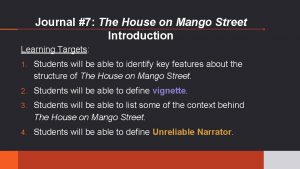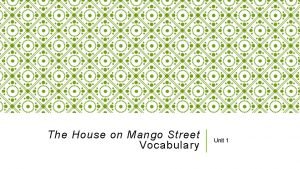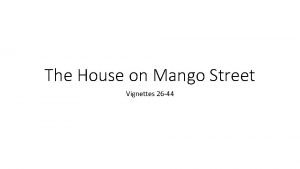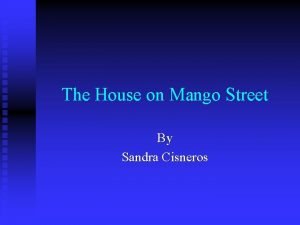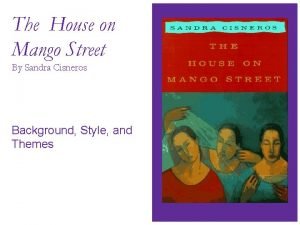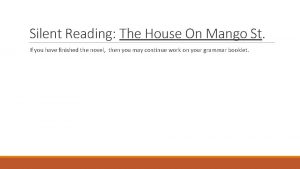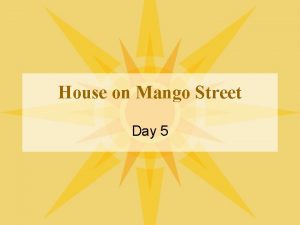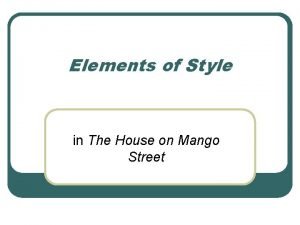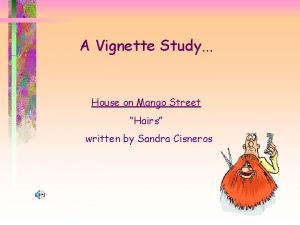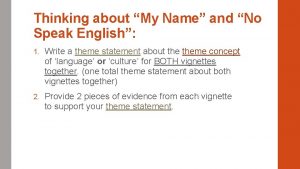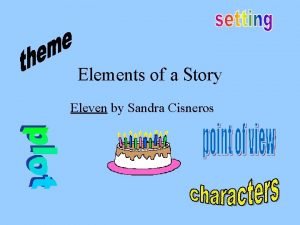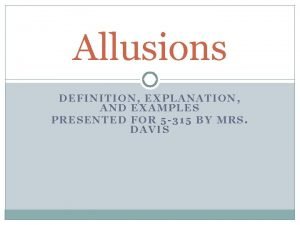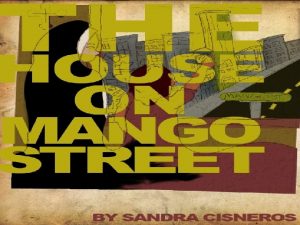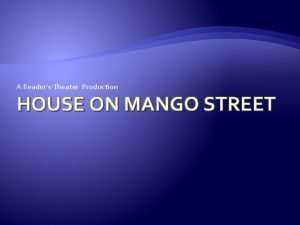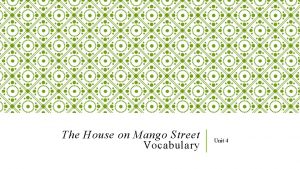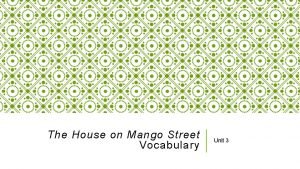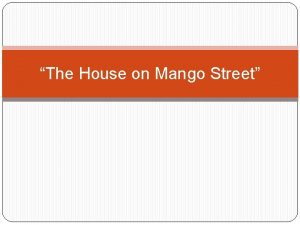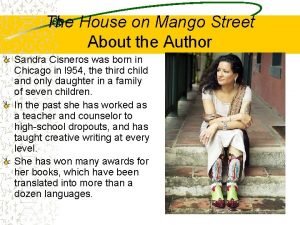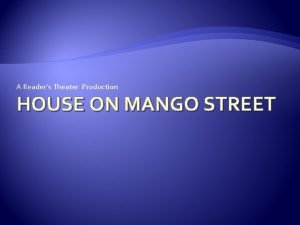Journal 7 The House on Mango Street Introduction




















- Slides: 20

Journal #7: The House on Mango Street Introduction Learning Targets: 1. Students will be able to identify key features about the structure of The House on Mango Street. 2. Students will be able to define vignette. 3. Students will be able to list some of the context behind The House on Mango Street. 4. Students will be able to define Unreliable Narrator.

Open The House on Mango Street and read “The House on Mango Street” (3 -5); “Hairs” (6 -7); and “Boys & Girls” (8 -9). 1. What was each section about? What was your impression of the passages? Their structure? What do you know about the narrator? 2. What did you notice about the structure, style, content, length, etc. of the text? List 2 things then talk to a neighbor and work together to come up with a total of 5 things. 3. Identify 1 -2 examples each of metaphor, simile AND personification. 2

Vignette A vignette is a short narrative passage that does not follow the typical grammatical structure, instead opting for a poetic approach. Each The House on Mango Street (HOMS) section is a Vignette. The word comes from French for ‘little vine. ’ Typically vignettes focus on one moment or character and try and evoke more meaning through figurative language and poetic structures than plot. 4. Why would an author choose to write vignettes? 3

“The House on Mango Street, ” “Hairs, ” and “Boys & Girls” Discussion: ▪ What is a narrator? ▪ What do we learn about our setting? ▫ How would you describe it? Is it like the plateau? 4

Unreliable Narrator the first person voice who’s perspective (the narrator) we experience the story through. They cannot always be relied on to be accurate, or may experience or interpret events differently than other characters or readers. The use of an Unreliable Narrator forces readers to question the text and read between the lines. ▪ Can be because characters experience or understand things differently due to age, inexperience, etc. ▪ Esperanza is an Unreliable Narrator 5. Was Pi an Unreliable Narrator? What challenges exist with reading an Unreliable Narrator? Why would an author intentionally use this technique? 5

Author: Sandra Cisneros ▪ Sandra Cisneros is an activist poet, short story writer, novelist, essayist and artist. Writing for over 50 years, her work explores the lives of working-class people. ▪ Her numerous awards include NEA fellowships in both poetry and prose, the Texas Medal of the Arts, a Mac. Arthur Genius Fellowship, as well as both national and international book awards. ▪ Recently she received the Ford Foundation's Art of Change Fellowship, Chicago's Fifth Star Award, the PEN Center USA Literary Award, the Arthur R. Velasquez Award from the National Museum of Mexican Art, and Loyola University's Arts & Science Damen Award. ▪ She received the 2015 National Medal of Arts presented to her by President Obama at the White House, she also received the Congressional Hispanic Caucus Institute's 2017 CHCI Chair's Award in Washington, D. C. 6

Sandra Cisneros: ▪ Born December 1954 in Chicago, Illinois. ▪ Cisneros was one of the first Hispanic-American writers who achieved commercial success. ▪ She is praised for her works which bring the perspective of Chicana (Mexican-American) women into mainstream literature. 7

Sandra Cisneros ▪ She writes about conflicts directly related to her upbringing: divided cultural loyalties (Mexican/American), feelings of alienation, and degradation associated with poverty. ▪ Growing up, she moved around frequently, especially between the US and Mexico, where her grandparents lived. ▪ These conflicts, and her feelings of alienation as a Latina, came to life in The House on Mango Street. ▪ The House on Mango Street, has sold over six million copies, has been translated into over twenty languages, and is required reading in elementary, high school, and universities across the nation. 8

Context for The House on Mango Street 6. What are the author’s purposes for writing this novel? Watch this video: https: //www. youtube. com/watch? v=0 Pyf 89 Vs. Nmg 7. Who is the audience for this novel? 8. Is The House on Mango Street a true story? Why or why not? 9

Context for The House on Mango Street ▪ The House on Mango Street is about the experiences of the invisible people in American society. ▫ What classes of people are invisible in America? What does this mean? ▫ In this case, women and Latino/Latinas/Latinx. ▪ Draws on Cisnero’s personal upbringing, as well as her adult experiences working in underprivileged high schools, as well as counseling minority college students. ▪ Story focuses on Esperanza, a poor Latina adolescent longing for a home (and life) she can be proud of. 10

Connecting Vignette Structure to Cisnero’s purpose ▪ Cisneros has said of her book that she “doesn’t want a book that a reader won’t understand would feel ashamed for not understanding” (xvii). ▪ Also commented that she wrote the book so that it “can be opened at any page and will still make sense to the reader who doesn’t know what came before or comes after” (xvii). 11

Context for The House on Mango Street Part of who Cisneros wrote The House on Mango Street for was the young women looking “for another way to be” outside what can be “inherited from our male dominated culture. ” Feminist idea about how many women don’t have a successful female role model to look up to ▪ How equal are women to men in our country, in other countries, eras, etc. ? ▫ In the school? Workplace? Positions of power? 12

NEW Learning Target: add at the beginning or wherever you are in your notes. 5. Students will be able to identify basic feminist ideas. 13

TRIGGER ALERT: For some of you this may seem to be a tense or sensitive issue. Scientifically speaking: When your brain hears an idea that you are fundamentally [already] opposed to at your core, it reacts to this with the same process as it would a physical threat to your safety ((i. e. : “DANGER!! FIGHT!! FLIGHT!! AHHH!! ”)) –this is not a threat to you in anyway. To remedy any negative emotional reactions you can: actively listen, thoughtfully share your opinion as supported by evidence, ask questions, or disengage. 14

Feminism Definitions: “the advocacy of women's rights on the basis of the equality of the sexes. ” “a range of political movements, ideologies, and social movements that share a common goal: to define, establish, and achieve political, economic, personal, and social equality of sexes. This includes seeking to establish educational and professional opportunities for women that are equal to those for men. ” “Feminist activist Bell Hooks calls it ‘a movement to end sexism, sexist exploitation, and oppression. ’“ 9. What is the essential claim of feminism definitions? 15

Few words in the English language spark more heated debate than the word feminism, a word with an expansive gap between the word’s actual definition and that by which society has defined it. While society’s preconceived notion of feminism has acquired negative connotations over the years, and the word has come to mean the superiority of the female sex, this concept is a far cry from the true definition of the word: the equality of the sexes. 16

A. B. Feminist Theory: Key Beliefs The relationship between men and women has almost always been unequal and oppressive. All known societies have been patriarchal. ▫ Patriarchy is a system in which males dominate females. ▫ While biology determines our sex (male or female), culture determines and defines our gender (masculine or feminine). Simone de Beauvoir writes : “One is not born, but rather becomes, a woman” C. All major social institutions have been characterized by male dominance: ▫ Economic ▫ Political system: ▫ US Senate: 22% women* (16 Dems/6 Repubs); House of Representatives: 19. 6% women (78 Dems/27 Repubs). ▫ US Senate has the all time current record. ▫ Only 6 states have female governors while there has only ever been 42 women serving in that role. ▫ Family ▫ Religion: for example, in the biblical portrayal of Eve as the origin of sin D. Elements of modern western masculinity have negative effects on men, as well as women. (“Toxic Masculinity”) 17

Continued E. Culture tends to make women invisible. ▫ The intellectual and artistic achievements of women are largely ignored. ▫ Some histories of art do not mention a single female artist. ▫ History is written as if women had no role in it and were hardly even present. ▫ Historians discuss a great length the violent war-making capacities of males. F. Society feels ownership over women’s bodies. ▫ Sexually, economically, and politically. G. Powerful and/or independent women are demonized by society. H. The typically assigned gender roles for women within families and society are often boring and unfulfilling. 18

What evidence for Feminist critiques of society can we find? ▪ Read the article. ▫ In writing: “Reply” to the two user comments Mr. Smith included. ▫ What is significant about trying to measure the ▫ ▫ disparity of men and women in power this way? Is this article fair? What questions do you have? ▪ NPR Story: “Nike Sees Executive Departures in Harassment Reckoning” ▫ https: //www. npr. org/2018/05/15/61044505 7/nike-sees-executive-departures-inharassment-reckoning ▫ Fowler: “Maybe men shouldn’t talk that way in a locker room either– secret sexism is just as bad as secret racism or homophobia. ”

What evidence for Feminist critiques of society can we find?
 House on mango street introduction
House on mango street introduction World literature vocabulary words
World literature vocabulary words The house on mango street vocabulary
The house on mango street vocabulary Sire the house on mango street
Sire the house on mango street Sandra cisneros career
Sandra cisneros career Indirect characterization in the house on mango street
Indirect characterization in the house on mango street Still i rise figurative language
Still i rise figurative language How do outsiders view esperanza’s neighborhood?
How do outsiders view esperanza’s neighborhood? House on mango street born bad
House on mango street born bad The house on mango street style
The house on mango street style The house on mango street hairs vignette
The house on mango street hairs vignette Theme of no speak english
Theme of no speak english Eleven story by sandra cisneros
Eleven story by sandra cisneros Mythological allusion examples
Mythological allusion examples The house on mango street review
The house on mango street review House on mango street
House on mango street How do outsiders view esperanza’s neighborhood
How do outsiders view esperanza’s neighborhood House on mango street
House on mango street House on mango street vocabulary
House on mango street vocabulary Mi nombre la casa en mango street
Mi nombre la casa en mango street Wall street journal manufacturing
Wall street journal manufacturing
